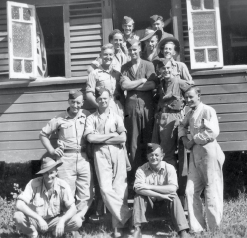Janine Roberts.
In July 2020 this photograph was sent to the Manning Wallamba Family History Society in Taree by the Glenbrook District Historical Society. The engraved rock, located at the entrance of the old Glenbrook Railway Tunnel at Lapstone Hill in the Blue Mountains, reads:
8 / 43
LAC R A Bryan
Taree
NSW
Who was R A Bryan and what role did he play in the history of this disused railway tunnel?
Here’s what I found
Ross Ashley Bryan was born in Taree in 1924. In 1943 he enlisted in the RAAF, perhaps with dreams of becoming a pilot. Instead Bryan underwent training as an armourer at Glenbrook RAAF base and on passing the course in August 1943 was posted to Glenbrook Tunnel.
Glenbrook Tunnel was one of 14 bulk storage facilities in Australia that was used to secretly store phosgene and mustard gas in case of chemical warfare attack from Japanese forces. Mustard gas had been used in WWI with devastating effects and as a result many countries, including Australia, became signatories to the Geneva Protocol 1925 prohibiting the use of chemical warfare. Japan however was not a signatory and had likely already used chemicals against the Chinese. In 1942 in a top-secret operation, Australia started importing one million chemical weapons from the UK and US.
A specialist chemical warfare unit was created to handle, transport and eventually destroy the stocks. Bryan was in this unit called the “Mustard Gas Men”. A daily duty was to release excess pressure that built up in the drums by unscrewing bungs to discharge the lethal gas into the air. Without suitable protective equipment, all men suffered gas burns and were constantly exposed to this carcinogen.
Eastern entrance of Glenbrook Tunnel with bulk storage drums filled with mustard gas. There is a guard dog outside the tunnel. After the war the tunnel was used to grow mushrooms as it was prior to the war. Photo taken mid 1943. National Archives of Australia. Photo courtesy of Geoff Plunkett.
Like the mushrooms previously grown in the tunnels, the men were never completely informed of the work they would be doing and signed documents which, under the Crimes Act, bound them to secrecy for 50 years. One armourer stated “It [mustard gas] wasn’t supposed to be in Australia…wasn’t meant to be here… So we just didn’t exist…”
After the war, Bryan married Valerie Kedwell at Coopernook and worked in a variety of jobs including motor mechanic at Taree, mill hand at Lansdowne and labourer at Gateshead.
It was not until the late 1990s that knowledge of these operations came to public notice and in 2009 the men of Glenbrook were recognised in a plaque-laying ceremony. Bryan died in 2005 unaware his sacrifice had been acknowledged, however through his rock carving we remember him today.
RAAF chemical warfare armourers at Innisfail 5 June 1944 as part of the chemical warfare research facility. Ross Ashley Bryan is wearing a belt standing on the steps behind the man sitting down. Photo courtesy of Geoff Plunkett.
(Special thanks to author Geoff Plunkett who shared his knowledge, photographs and book ‘Chemical Warfare in Australia: Australia’s Involvement in Chemical Warfare 1914 – Today’, Sydney: Leech Cup Books, 2013.)
Glenbrook Tunnel where drums are being cleaned and repainted by a chemical warfare armourer under a tarpaulin, Mid-1943. National Archives of Australia. Photo courtesy of Geoff Plunkett.


